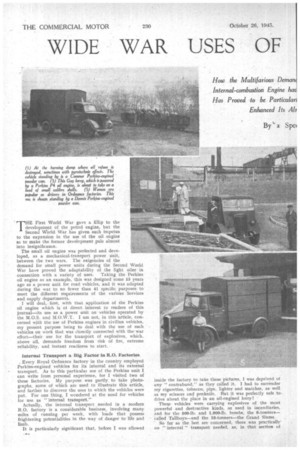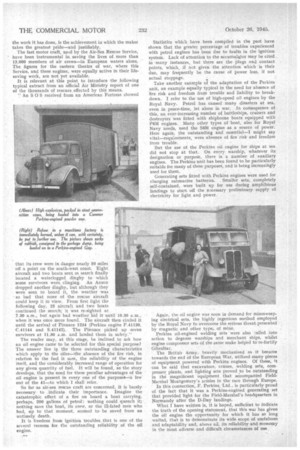WIDE WAR USES OF POPULAR OIL ENGINE
Page 26

Page 27

Page 28

If you've noticed an error in this article please click here to report it so we can fix it.
.MHE First World War gave a fillip to the
THE of the petrol engine, but the
Second World War has given such impetus to the expansion in the use of the oil engine as to make the former development pale almost into insignificance.
The small oil engine was perfected and developed, as a mechanical-transport power unit, between the two wars. The exigencies of the demand for small power units during the Second World War have proved the adaptability of the light oiler in connection with a variety of uses. Taking the Perkins oil engine as an example, this was designed some /5 years ago as a power unit for road vehicles, and it was adapted .during the war to no fewer than 41 specific purposes to meet the different requirements of the various Services and supply departments.
I will deal, first, with that application of the Perkins oil engine which is of direct interest to readers of this journal—its u-se as a power unit on vehicles operated by the M.O.S. and M.O.W.T. I am not, in this article, concerned with the use of Perkins engines in civilian vehicles, my present purpose being to deal with the use of such vehicles on work that was directly connected with the war effort—their use for the transport of explosives, which, above all, demands freedom from risk of fire, extreme reliability, and instant readiness to start.
Internal Transport a Big Factor in R.O. Factories
_ Every Royal Ordnance factory in the country employed Perkins-engined vehicles for its internal and its external transport. As to this particular use of the Perkins unit I can write from personal experience, for I visited two of these factories. My purpose was partly to take photographs, some of which are used to illustrate this article, and further to discover the uses to which the vehicles were put. For one thing. I wondered at the need for vehicles for use as " internal transport."
Actually, the internal transport needed in a modern R.O. factory' is a considerable business, involving many miles of running per week, with loads that possess frightening potentialities in the way of danger to life and limb.
It is particularly significant that, before I was allowed •••• inside the factory to take these pictures, I was deprived of any " contraband," as they called it. I had to surrender my cigarettes, tobacco, pipe, lighter and matches, as well as my scissors and penknife. But it was perfectly safe to. drive about the place in an oil-engined lorry!
These vehicles were carrying explosives of the most powerful and destructive kinds, as used in incendiaries, and for the 500-Ib. and 1,000-lb. bombs, the 6-tonnerscalled Tallboys—and the 10-tonners—the Grand Slams.
So far as the last are concerned, there was practically' no " internal " transport needed, as, in that section of
the factories, it was a case of working from hand to mouth. So soon as a " Grand Slam " was completed, it was put on a lorry and conveyed to the appropriate aerodrome. There it was loaded immediately into a waiting aeroplane, which at once took off with its .load. A fine example of door-to-door transport by road, and of perfect road and air co-operation.
But the point I am aiming at. is that these vehicles were used for carrying the most dangerous and inflammable of materials: the job was one Which demanded, above all things, absence of fire risk and absolute reliability. The boclyworktof most of the vehicles—powder vans they were called—is of special design, the construction, of course, complying with the regulations relating to such machines.
The cab is entirely separate, with a gap of at least 6 ins, between it and the body. It is backed by a steel sheet which projects above it and to within a foot of the ground.
The engine exhaust pipe terminates in front of the steel sheet. In that way the risk of accident is minimized, but the outstanding and most important precaution was the use of oil instead of highly inflammable petrol.
Inside the precincts of the factory these vehicles are used to carry the components and ingredients from group" to " group," as the various sections of the factory are called, as the bombs, shells, cartridges, etc., progressed froni raw material to the finished article.
Strict Enforcement of Vehicle Speed Limits
The external transport was equally important, onerous and dangerous. A certain percentage of every product had to be conveyed to distant testing grounds for trial, the figure given to me in this connection being one in 500. These testing grounds are as far afield as Cumberland, and the west and south coasts of Wales. The vehicle, with its dangerous load, must set out at any time of the day or night and travel to its destination. Sped limits were fixed: 30 m.p.h. during the daytime and 20 m.p.h. at night, and the strictest adherence to these limits was enforced on the drivers, all of whom, by the way, were specially picked men.
Records have not been kept of the mileage covered, but the machines I saw had been in continuous use since 1940 and had needed a minimum of maintenance.
But the first urgent demand, which the Perkins concern had to meet, was for marine engines to power air-sea rescue craft. The well-known P6 vehicle engine was at once adapted to that use. It became the P6M, in which guise, fitted with a suitable gearbox, it served that purpose admirably, up to a point: it was not quite big enough and a little more power than it could give was desired.
At once a big brother of the P6M,. the S6M, was put into production, and adapted tO this purpose. Its success, and
the work it has done, is the achievement in which the maker takes the greatest pride—and justifiably.
The fast motor craft, ussd by the Air-Sea Rescue Service, have been instrumental in saving the lives of. more than 13,000 members of air crews—in European waters alone. The figures for the eastern theatre of war, where this Service, and these engines, were equally active in their lifesaving work, are not yet available.
It is relevant at this point to introduce the following typical extract from an official Air Ministry report of one of the thousands of rescues effected by this means.
An S 0 S received from an American Fortress showed that its crew were in danger nearly 50 miles off a point on the south-west coast, Eight aircraft and two boats sent in search finally located a waterlogged dinghy to which some survivors were clinging. An Anson dropped another dinghy, but although they were seen to board it, the weather was
• so bad that none of the rescue aircraft could keep it in view. From first light the following day, 25 aircraft and two boats continued the search; it was re-sighted at 7.30 a.m., but again bad weather hid it until 10.30 a.m., when it was once more found. The aircraft then circled it until the arrival of Pinnace 1234 (Perkins engine P.41130, C.91I44 and S.41142). The Pinnace picked up seven survivors at 11.30 a.m, and landed them in safety."
The reader may, at this stage, be inclined to ask how an oil engine came to be selected for this special purpose? The answer lies in the three outstanding characteristics which apply to the oiler—the absence of the fire risk, in relation to the fuel it uses, the reliability of the engine itself, and the considerably increased range of operation for any given quantity of fuel. It will be found, as the story develops, that the need for these peculiar advantages of the oil engine is present in every one of the purposes—a few out of the 41—to which I shall refer.
So far as air-sea rescue craft are concerned, it is barely necessary to _indicate their importance. Imagine the catastrophic effect of a fire on board a boat carrying, perhaps, 200 gallons of petrol: nothing could quench it; nothing save the boat, its crew, or the ill-fated men who had, up to that moment, seemed to be saved from an untimely death.
It is freedom from ignition troubles that is one of the several reasons for the outstanding reliability of the oil engine.
Statistics which have been compiled in the past have shown that the greater percentage of troubles, experienced with petrol engines has been due to faults in the ignition system. Lack of attention to the accumula,tor may be cited. in -many instances, but there are the plugs and contact points, which, if not given the attention which is 'their due, may frequently be the cause of power loss, if not actual stoppage.
Take another example of the adaptation of the Perkins unit, an example -equally typical in the need for absence of fire risk and freedom from trouble and liability to breakdown. I refer to the use of high-speed oil engines by the Royal Navy. Petrol has caused many disasters at sea, even in peace-time, let alone in war. In consequence of this, an ever-increasing number of battleships, cruisers and destroyers was fitted with shipborne boats equipped with PfiM engines. Many. other types of boat, also for Royal Navy needs, used the S6I1,1 engine as a source of power. Here again, the outstanding and essential—I might say vital—requirements, were absence of fire risk and freedom from trouble. • But the use of the Perkins oil engine for ships at sea did not stop at that. On every warship, whatever its designation or purposb, there is a number of auxiliary engines. The Perkins unit has been found to be particularly suitable for many of these purposes, and iS being increasingly used for them.
Generating sets fitted with Perkins engines were used for
charging submarine batteries. Smaller sets, completely self-contained, were built up for use during amphibious landings to start off the nscessary preliminary supply of electricity for light and power.•
Again, the oil engine was soon in demand for minesweeping electrical sets, the highly ingenious method employed by the Royal Navy to overcome the serious threat presented by magnetic and other type:, of mine. Perkins oil-engined welding sets were also sailed into action to degauss warships and merchant ships, whilst engine compressor sets of the same make helped to re-fOrtify Gibraltar.
The British Army,. heavily mechanized as it became towards the end of the European War, utilized many pieces of equipment powered with Perkins engines. Of these, it can be said that excavators, cranes, welding sets, compressor plants, and lighting sets proved to be Outstanding in the magnificent 'equipment that accompanied FieldMarshal IVIontgornery's armies in the race through Europe.
In this connection, .F. Perkins, Ltd., is particularly proud of the fact that it was a Perkins-engined generating set that provided light for the Field-Marshal's headquarters in Normandy after the D-Day landings.
What I have written is, it is hoped, sufficient to indicate the truth of the opening statement, that this war has given the oil engine the opportunity for which it has so long waited, that is to demonstrate its wide scope of usefulness and adaptability and, above all, its reliability and economy in the most adverse and difficult circumstances of use




















































